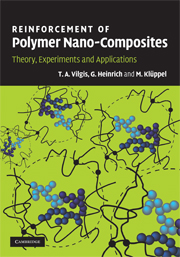Book contents
- Frontmatter
- Contents
- Preface
- Acknowledgement
- 1 Introduction
- 2 Basics about polymers
- 3 Many-chain systems: melts and screening
- 4 Rubber formation
- 5 The elastomer matrix
- 6 Polymers of larger connectivity: branched polymers and polymeric fractals
- 7 Reinforcing fillers
- 8 Hydrodynamic reinforcement of elastomers
- 9 Polymer–filler interactions
- 10 Filler–filler interaction
- References
- Index
1 - Introduction
Published online by Cambridge University Press: 06 January 2010
- Frontmatter
- Contents
- Preface
- Acknowledgement
- 1 Introduction
- 2 Basics about polymers
- 3 Many-chain systems: melts and screening
- 4 Rubber formation
- 5 The elastomer matrix
- 6 Polymers of larger connectivity: branched polymers and polymeric fractals
- 7 Reinforcing fillers
- 8 Hydrodynamic reinforcement of elastomers
- 9 Polymer–filler interactions
- 10 Filler–filler interaction
- References
- Index
Summary
The reinforcement of composite materials is far from being a simple problem [1]. Reinforced elastomers, which find application in the car tire industry, are typical and well-known examples of that. Indeed, these materials allow a physical formulation of most of the problems and offer a suggestion for a solution. Complications arise due to the many length and time scales involved and this is one of the issues which will be examined in this book.
The basic aim of filling relatively soft networks, i. e. cross-linked polymer chains, is to achieve a significant reinforcement of the mechanical properties. For this purpose, active fillers like carbon black or silica are of special practical interest as they lead to a stronger modification of the elastic properties of the rubber than adding just hard randomly dispersed particles. The additional reinforcement is essentially caused by the complex structure of the active fillers (see, e.g., [2] and references therein).
The main aim of the present work is to gain further insight into this relationship between disordered filler structure and the reinforcement of elastomers. As a filler type we have chiefly in mind carbon black, which shows “universal” (i. e. carbon-black-type-independent) structural features on different length scales, see Fig. 1.1: carbon black consists of spherical particles with a rough and energetically disordered surface [3, 4]. They form rigid aggregates of about 100 nm across with a fractal structure. Agglomeration of the aggregates on a larger scale leads to the formation of filler clusters and even a filler network at high enough carbon black concentrations. Reinforcement is thus a multiscale problem.
- Type
- Chapter
- Information
- Reinforcement of Polymer Nano-CompositesTheory, Experiments and Applications, pp. 1 - 9Publisher: Cambridge University PressPrint publication year: 2009



